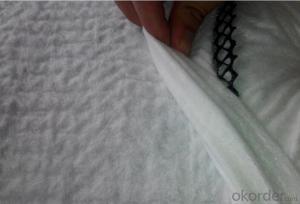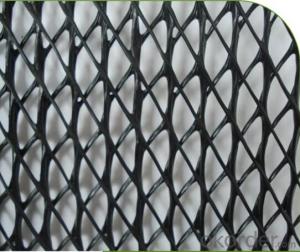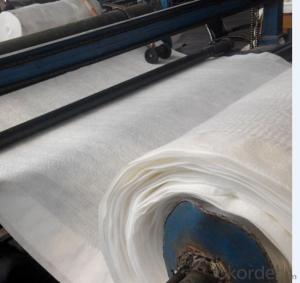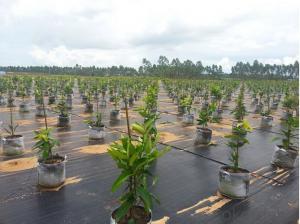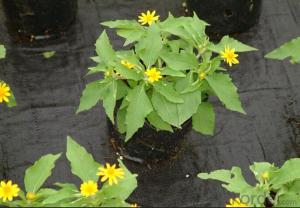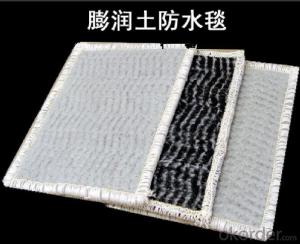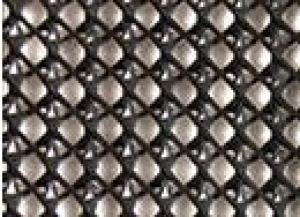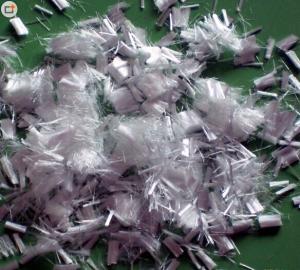Geotextile Compounded to Dimple Waterproof Drainage Board Geocomposite
- Loading Port:
- Qingdao
- Payment Terms:
- TT OR LC
- Min Order Qty:
- 2000 m²
- Supply Capability:
- 200000 m²/month
OKorder Service Pledge
OKorder Financial Service
You Might Also Like
Dimple waterproof drainage mat board
1. 8mm 12mm 16mm and 20mm height
2. drainage water and waterproofing
3. ISO CE
Drainage Board Introduction
Composite drainage board is a dimple geomembrane,which produced by extruding plastic sheet into dimple shape.These dimples, in spatial structure with certain height ,can resist long-term high pressure without deformation.On the top of the dimples,there is filtration geotextile to make sure the drainage channel runing well without any block for any articles,for example,filling particles or concrete.
Drainage board Typical application:
Landscape engineering:garage top greening,roof garden,football field,golf course,beach project.
Municipal engineering:road base,subway,tunnel,landfill.
Construction engineering :upper or bottom layer of building foundation,basement wall,bedding filtration and heat insulation.
Traffic engineering:highway,railway basement,dam and slope.
Drainage board Typical Features:
1)Excellent drainage function, can bear long time hige press load
2)High tensile and shear strength
3Reduce the rate geotextile embedding into the core of geonet, can protect long time stable water conductivity
4)Tri-dimension composite geonet for drainage can bear more than 2000kpa compression load
5)Its anti-compression capacity is much larger than common geonet for drainage
6) Certificate :ISO14001:2004, ISO9001:2008
Specifications and technical parameters:
Drainage network core | units | Specification | ||||
Unit weight | g/m2 | 750 | 1000 | 1300 | 1600 | |
Thickness | Mm | 5.0 | 6.0 | 7.0 | 7.6 | |
Hydraulic conductivity | m/s | kx10-4 | Kx10-4 | Kx10-4 | Kx10-4 | |
Elongation | % | 50 | 50 | 50 | 50 | |
Tensile strength (core netwaork) | kN/m | 8 | 10 | 12 | 14 | |
Geotextile | g/m2 | Heavier grades of geotextiles can be bonded to geonet on request | ||||
Usages:
In the railway, highway and other transportation infrastructure, drainage system safety and the service life
of the project and its have inseparable relationship, in which the geotextile material is an important part
of drainage system, the drainage effect of 3D composite drainage net is particularly notable. mainly
used for tunnels, municipal engineering, reservoir, revetment in drainage engineering.
FAQ
1. Which payment do you accept?
For you convinience,our payment can be L/C,TT
2. Is free sample available?
We can supply free samples if you need.
3. How about your quality?
We have strict quality control system, we make testing on incoming raw material and finished products. Your third party testing is also welcomed. With high quality, our products are used on government projects at home and abroad. Our product quality is accepted by clients from all over the world
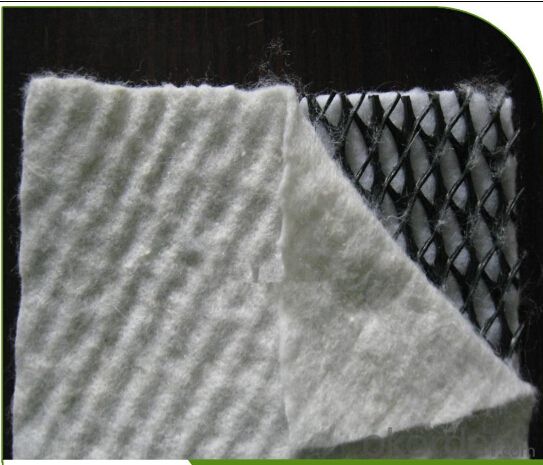
- Q:What are the different types of geosynthetic clay liners available?
- There are several types of geosynthetic clay liners (GCLs) available, including sodium bentonite GCLs, calcium bentonite GCLs, and polymer-modified GCLs. Sodium bentonite GCLs are commonly used due to their high swelling capacity and excellent hydraulic conductivity. Calcium bentonite GCLs offer similar properties but with a lower swelling capacity. Polymer-modified GCLs are enhanced with polymers to improve their strength and durability.
- Q:How are geosynthetic materials tested for quality and performance?
- Geosynthetic materials are tested for quality and performance through a series of standardized laboratory tests and field evaluations. These tests typically involve measuring properties such as tensile strength, puncture resistance, durability, and UV stability. Additionally, geosynthetics are subjected to accelerated aging tests to simulate long-term exposure to environmental conditions. Field evaluations may include installation tests to assess ease of installation and performance under real-world conditions. Overall, rigorous testing procedures ensure that geosynthetics meet the required standards and perform reliably in various geotechnical applications.
- Q:Can earthwork products be used in residential construction projects?
- Yes, earthwork products can be used in residential construction projects. These products, such as soil, gravel, and aggregates, are commonly used for site preparation, foundation construction, drainage systems, landscaping, and other related activities in residential construction projects.
- Q:What are the different applications of geotextile bags?
- Geotextile bags have various applications, including erosion control, shoreline protection, sediment filtration, construction site dewatering, flood control, and land reclamation. These bags are also used for slope stabilization, soil reinforcement, and as a barrier for retaining walls. Additionally, geotextile bags can be employed in environmental remediation projects, such as containment of contaminated soil or sludge.
- Q:How do geosynthetic liners contribute to groundwater recharge in water storage facilities?
- Geosynthetic liners help to prevent water from leaking out of water storage facilities, ensuring that more water is retained. This retained water can then slowly seep into the ground, replenishing groundwater sources and contributing to groundwater recharge.
- Q:What are the advantages of using geosynthetic liners in agricultural applications?
- Geosynthetic liners offer several advantages in agricultural applications. Firstly, they provide excellent containment and prevent seepage of liquids, such as fertilizers and pesticides, into the soil. This helps in maintaining the quality of the soil and prevents contamination. Secondly, geosynthetic liners act as a barrier against invasive species, preventing their spread into agricultural fields. This helps in protecting crops and maintaining their health. Additionally, these liners help in conserving water by reducing evaporation and seepage, thus promoting efficient water usage in irrigation systems. This is particularly beneficial in areas with limited water resources. Furthermore, geosynthetic liners are durable and resistant to wear and tear, making them a long-lasting solution for agricultural applications. They can withstand heavy loads and various weather conditions, ensuring reliable performance. Overall, the use of geosynthetic liners in agriculture provides effective containment, protects soil quality, conserves water, and enhances the overall productivity and sustainability of farming practices.
- Q:Are earthwork products resistant to graffiti?
- No, earthwork products are not inherently resistant to graffiti.
- Q:What are the different colors and textures available in earthwork products?
- The colors and textures available in earthwork products can vary depending on the specific material. For example, in soil products, colors can range from various shades of brown to gray, while the textures can range from fine and sandy to coarse and gravelly. Additionally, in rock and stone products, colors can range from vibrant reds and yellows to more subdued grays and blacks, with textures varying from smooth and polished to rough and jagged.
- Q:What are the benefits of using sediment basins?
- Sediment basins offer several benefits, including the prevention of soil erosion and sediment runoff, which can contribute to water pollution. They effectively trap sediment and prevent it from reaching nearby water bodies, preserving water quality and aquatic ecosystems. Sediment basins also help in controlling and managing stormwater runoff, reducing the risk of flooding and soil degradation. Additionally, they provide an opportunity for sediment to settle, allowing for the collection and removal of contaminants before they reach sensitive areas, thus protecting downstream habitats and infrastructure.
- Q:Material in the civil engineering in what kind of position
- You said that material important is not important. It can be said that the material is the cornerstone of civil engineering. No material what is the air castle.
1. Manufacturer Overview |
|
|---|---|
| Location | |
| Year Established | |
| Annual Output Value | |
| Main Markets | |
| Company Certifications | |
2. Manufacturer Certificates |
|
|---|---|
| a) Certification Name | |
| Range | |
| Reference | |
| Validity Period | |
3. Manufacturer Capability |
|
|---|---|
| a)Trade Capacity | |
| Nearest Port | |
| Export Percentage | |
| No.of Employees in Trade Department | |
| Language Spoken: | |
| b)Factory Information | |
| Factory Size: | |
| No. of Production Lines | |
| Contract Manufacturing | |
| Product Price Range | |
Send your message to us
Geotextile Compounded to Dimple Waterproof Drainage Board Geocomposite
- Loading Port:
- Qingdao
- Payment Terms:
- TT OR LC
- Min Order Qty:
- 2000 m²
- Supply Capability:
- 200000 m²/month
OKorder Service Pledge
OKorder Financial Service
Similar products
New products
Hot products
Hot Searches
Related keywords

